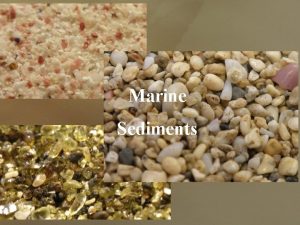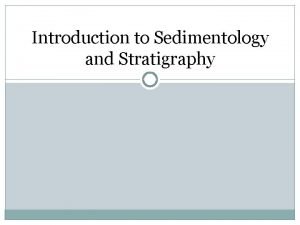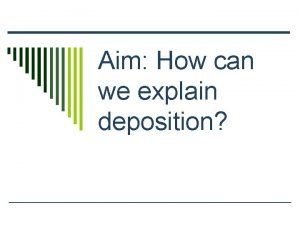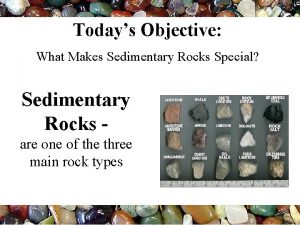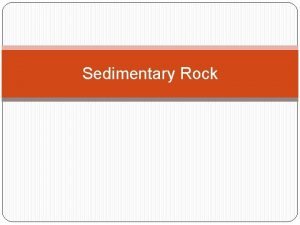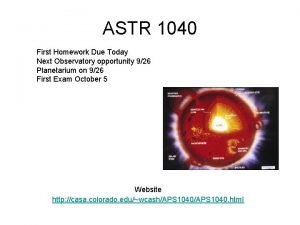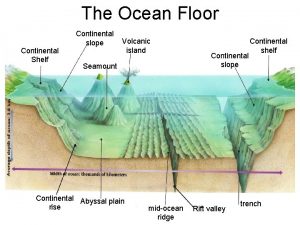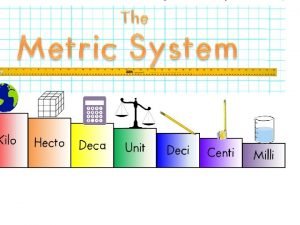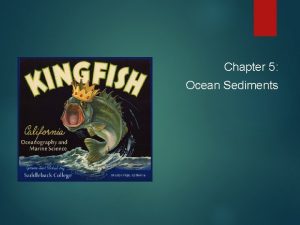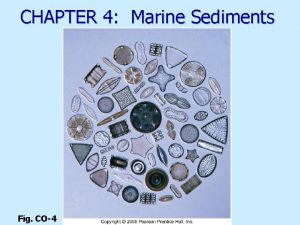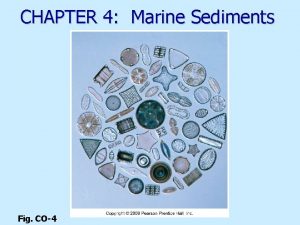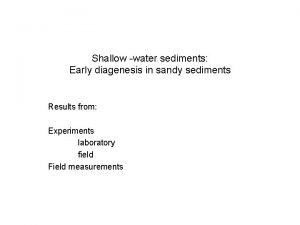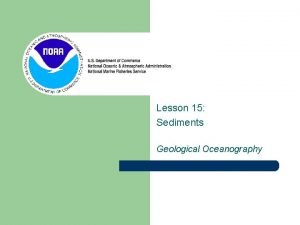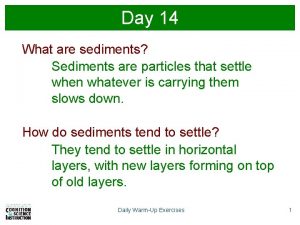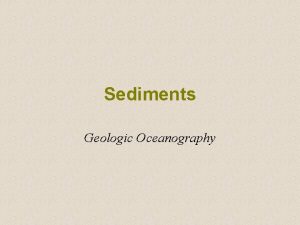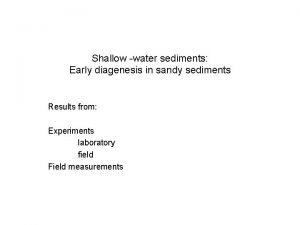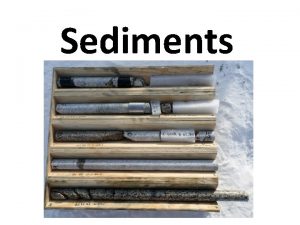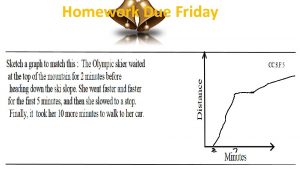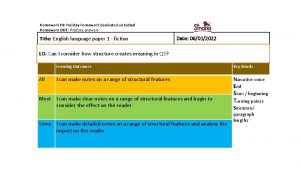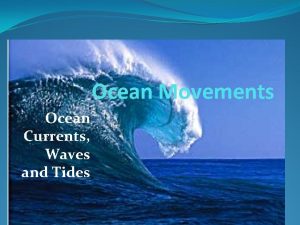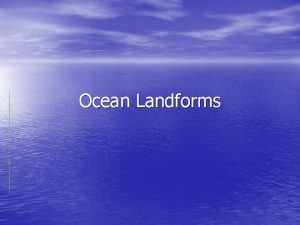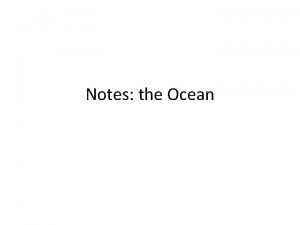CHAPTER 5 OCEAN Sediments HOMEWORK 1 DUE Long









































- Slides: 41

CHAPTER 5 ~ OCEAN Sediments

HOMEWORK 1 DUE (Long Marine lab Field Trip) Turn in after class See Syllabus-revised Webpage

• HOMEWORK –problem sets 2 • Late Policy: Lab assignments are due the week after posting. ~ mondays • We ask that you complete your work on time, and will deduct 10% of the credit per day for any late assignments. NO EXCEPTIONS. If you have questions about or need help on the assignments, we invite you to come to the TAs' office hours. • If you can't make office hours, we encourage you to make an appointment to meet with the TAs. • TA – Sami – alesix 78@gmail. com

OUTLINE The Oceans Memory Foundations of Paleoceanography Classification of Marine Sediments Sedimentary Processes Global Distribution of Sediments

• The Oceans Memory – Paleoceanography? Sediments tell a story • Study of Oceans sedimentary record – Analyze Sediment Cores Challenge Question What is the Principle of Superposition? In a deposit of undisturbed sedimentary rocks, oldest rocks at the bottom, youngest at the top

OUTLINE The Oceans Memory Foundations of Paleoceanography Classification of Marine Sediments Sedimentary Processes Global Distribution of Sediments

Foundations of Paleoceanography • Cesare Emiliani (1922 -1995) – Godfather of Paleoceanography – Measure ratio oxygen (18 O) vs normal oxygen (16 O) • in shells of Fomanifera (plankton) • Varies w/ temp. – Good Indicator of sea. H 2 O temp/time » Cold H 2 O (high [18 O] vs 16 O » Warm H 2 O (low [18 O] vs 16 O » aka - delta O-18 » Look at O-18 in sediment cores

Foundations of Paleoceanography • Emergence of Kullenberg piston corer – Cores of 10 -20 m into ocean basins. . . • Representing 1 -2 million years of sediments

Foundations of Paleoceanography • DEEP Sea Drilling Projects (Sediment Cores) • NSF (1971 -1982) – Changes in Climate ~ 700, 000 years Climate: Long Range Investigation, Mapping and Prediction aka (CLIMAP) – Demonstrated Ice Ages result from Mileneum-Scale deviations From Earth’s Orbit around Sun -aka Milankovitch cycle

Milankovitch cycles (1 -3) I 2 Challenge Question? 3 What do the Milankovitch cycles vary the amount of? Solar radiation that reaches the earth What can this lead to / result in? ~ 10*C temp changes Ice Ages

1 From Sediment Cores 2 3 4 5 6 Heinrich Events discovered – What are they? Abrupt climate change/ rapid cooling within decades/ centuries 6 in last 75, 000 years. . . Scientists concerned modern lifestyle leading to another. . . e. g. Global Warming Mini ice age. . . http: //www. youtube. com/watch? v=Cs 56_Gq. Ty. IQ&feature=related

• Confirming your Knowledge – Using plankton (fomanifera) shells what elemental • ratio is used to gauge cold/warmer sea water temp/time? – delta O 18 vs O 16 – What are Heinrich events/ how many occurred in last 75000 years? • Rapid change in seawater temp/decades, 6

OUTLINE The Oceans Memory Foundations of Paleoceanography Classification of Marine Sediments Sedimentary Processes Global Distribution of Sediments

Classification of Marine Sediments many source types: -based on grain size & organism type Old Ocean Sediments: Mostly Phytoplankton Formanifera (carbonate) ooze - 50% Diatom (silica) ooze - 15% Phytoplankton Ocean Sediment CORE

OUTLINE The Oceans Memory Foundations of Paleoceanography Classification of Marine Sediments Sedimentary Processes Global Distribution of Sediments

Sedimentary Processes What are they? = production, transport, deposition of sediments

Sedimentary Processes How and where do sediments move about on the planet? 1. Starts w/ the Hydrologic Cycle -Exchange of H 2 O b/w various reservoirs

Sedimentary Processes 2. Continental Weathering – what is it? Dissolving, fracturing/ chemical alteration of rocks – -important role in cycling of elements (Iron, Calcium etc. ) and salinity in Sea Water • Challenge Question • What are the 3 types weathering processes? • 1. Physical – breaking apart of rocks via – Rock slides, earthquakes, debris flow • 2. Chemical – dissolving of rocks via – Natural acidic rain, rivers etc. • 3. Biological – activities of organisms via – fracture, dissolve, chemically alter rocks etc.

Sedimentary Processes • Sediment Sinking • Grain size effects sinking – Sediment traps measure carbon flux • Estimates Global carbon cycle • Important For study of Climate change – plankton

Sedimentary Processes • Biological sedimentation – The biological pump – complex – phytoplankton Where does CO 2 come from? • aka algae = Phyto. Plankton ~ = Trees Take in CO 2 (from Atmosphere) give off Oxygen Challenge Q Which Produces more O 2 (Air) for earth and by how much? Algae, 70 -80%! Lots of Stored Carbon (CO 2) in sediments

Sedimentary Processes • Calcium-Carbonate (calcite) Compensation Depth (CCD) – Below certain depth, calcite shells dissolve – aka “the lysocline” – Challenge Q • What factors influence the solubility (dissolution) of calcite shells? – Lower temp. , Higher pressure

Sedimentary Processes • Calcium-Carbonate (calcite) Compensation Depth (CCD) – The CCD - What is it? • Depth/Region where: solid Calcite shells = dissolving Calcite shells – No net change (1: 1) • Area of high plankton growth – shallow CCD (Artic, Antartic) • Area of low plankton growth – deep CCD (Hawaii) – Based on solubility of Calcite in Water (think of Sugar in Water) » If have LOTS, area is saturated (need more Liq. space to dissolve it) ALGAE HAWAII-clear H 2 O ALGAE Antartic Green/dark H 2 O Lots of algae Shells dissolve Artic Green/dark H 2 O Lots of algae

OUTLINE The Oceans Memory Foundations of Paleoceanography Classification of Marine Sediments Sedimentary Processes Global Distribution of Sediments

Global Distribution of Sediments • Calcite (Carbonate) sediments occupy – ~68% Atlantic ~36% Pacific • Lower microorganism (algae growth) responsible? Final Challenge Q Why does the N. Pacific NOT have the same Calcite deposition as the N. Atlantic? Think Geology (bathymetry) No Mid ocean ridge In N. Pacific for shells to land on They dissolve before then Can settle on something (calcite) –Red clay occupies deepest regions

Global Distribution of Sediments

OUTLINE The Oceans Memory Foundations of Paleoceanography Classification of Marine Sediments Sedimentary Processes Global Distribution of Sediments BREAK

Page 73

Fig. 5. 9

Fig. 5. 18

Fig. 5. 2

Fig. 5. 5

Fig. 5. 7

Fig. 5. 8

Fig. 5. 8. a

Fig. 5. 8. b

Fig. 5. 8. c

Fig. 5. 12

Page 81

Page 84

TABLES

Tab. 5. 1
 Chapter 15 ocean water and ocean life wordwise answer key
Chapter 15 ocean water and ocean life wordwise answer key Tall+short h
Tall+short h Once upon a time there lived
Once upon a time there lived Convergent ocean to ocean
Convergent ocean to ocean Ocean ocean convergent boundary
Ocean ocean convergent boundary Convergent plate boundaries
Convergent plate boundaries Ocean ocean convergent boundary
Ocean ocean convergent boundary Ice age scrat underwater
Ice age scrat underwater Convergent oceanic oceanic plate boundary
Convergent oceanic oceanic plate boundary Red ocean strategi
Red ocean strategi Classification of marine sediments
Classification of marine sediments What are sedimenta
What are sedimenta A low hill is composed of unsorted sediments
A low hill is composed of unsorted sediments A process that squeezes, or compacts, sediments
A process that squeezes, or compacts, sediments Sedimentary rock
Sedimentary rock Biochemical sedimentary rocks
Biochemical sedimentary rocks The process that presses sediments together
The process that presses sediments together Lithogenous sediment definition
Lithogenous sediment definition Jack prelutsky homework oh homework
Jack prelutsky homework oh homework Homework oh homework i hate you you stink
Homework oh homework i hate you you stink Parts of a poem
Parts of a poem Homework oh homework jack prelutsky
Homework oh homework jack prelutsky Homework oh homework i hate you you stink
Homework oh homework i hate you you stink Homework oh homework i hate you you stink
Homework oh homework i hate you you stink Folk culture and popular culture venn diagram
Folk culture and popular culture venn diagram Homework is due on friday
Homework is due on friday Homework is due on friday
Homework is due on friday Homework due today
Homework due today Homework due today
Homework due today Homework due tomorrow
Homework due tomorrow Homework due today
Homework due today Homework is due
Homework is due Iron core
Iron core Homework due today
Homework due today Homework due today
Homework due today Famiglia dei parallelogrammi
Famiglia dei parallelogrammi Substantive vs procedural due process
Substantive vs procedural due process Pentacosiomedimni cavalieri zeugiti teti
Pentacosiomedimni cavalieri zeugiti teti Principio di conservazione della quantità di moto
Principio di conservazione della quantità di moto Ocean basin
Ocean basin Electrostatics equations
Electrostatics equations Decaliter
Decaliter










